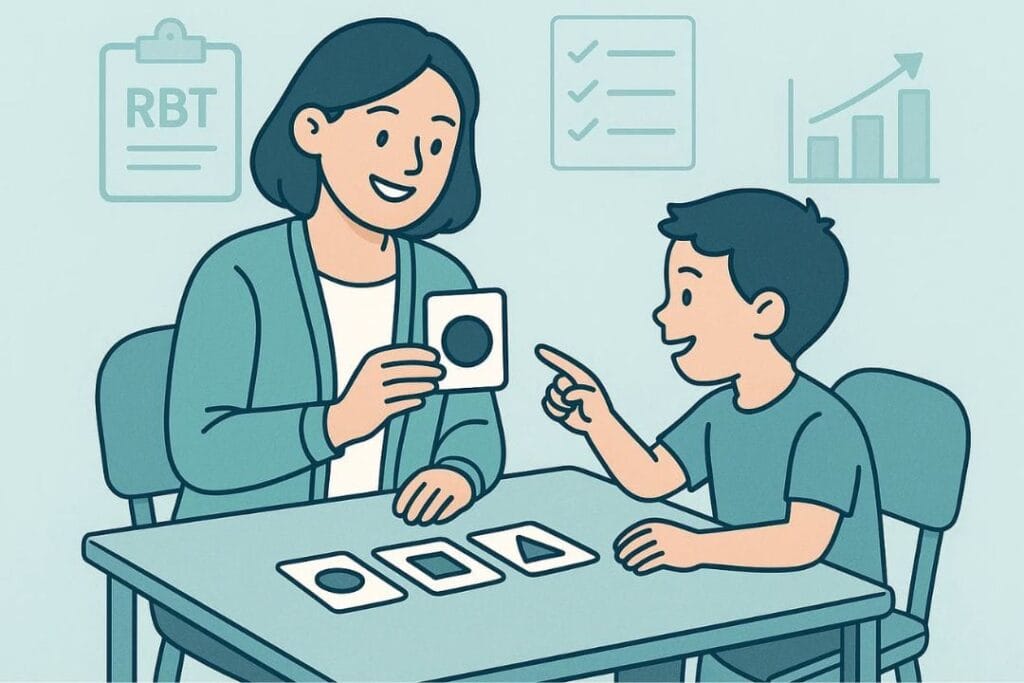If you’re considering a career in Applied Behavior Analysis (ABA), you’ve probably heard of the Registered Behavior Technician (RBT) role. But what exactly does an RBT do on a daily basis? Is it just about following instructions, or does it involve deeper client interaction and skill-building?
The truth is, RBTs are at the heart of ABA services. They work directly with clients—often children with autism or developmental disabilities—implementing treatment plans designed by a supervising BCBA (Board Certified Behavior Analyst) or BCaBA (Board Certified Assistant Behavior Analyst).
In this guide, I’ll walk you through the core responsibilities of an RBT, what their typical day looks like, and why this role is so valuable in the field of ABA.

RBT Responsibilities at a Glance
According to the RBT Task List 2.0, an RBT’s job revolves around six major areas:
- Measurement – Collecting and recording data on client behavior.
- Assessment – Assisting in skill assessments under supervision.
- Skill Acquisition – Teaching clients new skills using ABA strategies.
- Behavior Reduction – Implementing behavior intervention plans (BIPs).
- Documentation & Reporting – Maintaining accurate records.
- Professional Conduct – Following ethics and scope of practice.
Let’s break down what these actually look like in real life.
Daily Tasks of an RBT
1. Collecting Behavior Data
One of the most important responsibilities of an RBT is measurement. You’ll collect data during every session to track client progress. This might include counting how many times a behavior occurs (frequency), measuring how long it lasts (duration), or recording whether a behavior happens during specific intervals of time.
Accurate data allows the BCBA to evaluate whether a treatment plan is effective—or if it needs adjustment.
2. Teaching New Skills
Skill acquisition is where RBTs make a huge impact. Using strategies like Discrete Trial Training (DTT), Natural Environment Teaching (NET), or prompting and reinforcement, you’ll teach clients everyday skills such as:
- Communication (using words, signs, or communication devices)
- Social skills (greeting peers, taking turns)
- Daily living skills (brushing teeth, dressing, meal prep)
- Academic skills (colors, numbers, letters)
Every teaching moment is structured but personalized to the client’s needs.
3. Implementing Behavior Intervention Plans
Another major role of RBTs is helping reduce problem behaviors that interfere with learning or daily life. You’ll implement behavior intervention plans (BIPs) designed by your supervisor.
This might include strategies like teaching alternative behaviors, reinforcing appropriate actions, or carefully managing triggers that lead to problem behaviors.
Importantly, RBTs don’t create these plans—they implement them consistently under supervision of BCBA or BCaBA.
4. Documenting and Reporting
After each session, RBTs are required to document what happened. This includes writing session notes, updating graphs, and reporting any unusual incidents. Documentation is not just paperwork—it’s part of ethical practice and ensures treatment is transparent, measurable, and effective.
5. Collaborating with Supervisors
RBTs never work alone. They receive ongoing supervision from a BCBA or BCaBA. Supervisors review data, provide feedback, and sometimes observe sessions directly. Collaboration is essential, because it ensures the client receives high-quality, ethical services at all times.
6. Maintaining Professional Conduct
Finally, an RBT must always follow the BACB’s ethical guidelines. This means staying within your scope of practice, respecting client confidentiality, protecting client dignity, and seeking guidance whenever you encounter something outside your training.
Also Read: How to get RBT certification
What a Typical Day Looks Like for an RBT
- Morning: Arrive at a clinic or client’s home, review the session plan, and set up materials. Begin session with skill acquisition programs (e.g., practicing communication skills).
- Midday: Collect data on skill targets and challenging behaviors, take short breaks, and engage the client in natural teaching opportunities.
- Afternoon: Work on behavior reduction strategies, social interaction tasks, or daily living skills. End the session by completing documentation and discussing progress with the supervisor if needed.
Each day may look slightly different depending on the client’s needs, but the foundation remains the same: data collection, teaching, behavior support, and documentation.
Why RBTs Are So Important?
RBTs are often the ones spending the most time directly with clients. They are the frontline professionals who make ABA plans come to life. Without RBTs, supervisors wouldn’t have the hands-on data or consistent implementation needed to make treatment effective.
Being an RBT requires patience, consistency, and compassion—but it’s also incredibly rewarding. You get to see the small wins and breakthroughs that make a real difference in a client’s life.
Final Thoughts
So, what does an RBT do? In short: they teach, support, measure, and report. They follow the plans created by their supervisors and provide the hands-on work that drives client progress in ABA programs.
If you’re considering this career path, know that while the work can be challenging, it’s also one of the most rewarding jobs in the ABA field. As an RBT, you’ll not only gain valuable experience but also play a direct role in helping individuals build independence and improve their quality of life.
